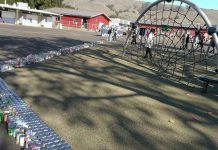The building of brand new $20 million elementary school on a donated 10-acre plot in a scenic, affluent northeast Morgan Hill neighborhood comes with one major concern for local officials: high concentrations of a harmful pesticide in the soil.
District leaders are not taking the matter lightly, and have been working with environmental consultants to find the most effective way to cleanse the former farmland to make way for a ninth primary school to serve Morgan Hill’s ever growing student population.
One option being explored, called bioremediation, was used back in 2005 for that very reason and the initial results were effective. However, the toxicity levels returned when the soil was tested again 10 years later.
“We want to be practical, but also extremely safe,” said Trustee David Gerard during the June 21 discussion of the Peet Road property donated to Morgan Hill Unified School District by the Borello family.
The school board took no action at Tuesday’s meeting and will come back at a future date to decide on how to best clean up the property.
The Borellos—a longtime local farming family—continue to build a neighborhood of new executive homes surrounding the proposed school site area that intersects Peet Road at Mission Avenida and borders a Santa Clara County water pump station at the far eastern foothills.
However, soil testing done a decade ago and then again in 2014 detected dangerous levels of now banned pesticides in the soil once used to farm the vast agricultural spread—including a chemical identified as dieldrin. According the Environmental Protection Agency, dieldrin decreases the effectiveness of the immune system, may increase infant mortality, reduces reproductive success, may cause cancer, may cause birth defects and damages the kidneys.
“(The possible use of) bioremediation is a concern we as staff have that is actually escalated by the fact that it was determined that bioremediation was effective for this very site for the very toxin of dieldrin which has either rebounded or some way returned,” Superintendent Steve Betando said. “So that is high on our radar and really at the crux of the concern that we’re talking with our consultant about.”
After an initial site assessment in 2003, bioremediation was used to shock the soil and reduce the pesticide concentrations to a safe level. Bioremediate means to use biological organisms to solve an environmental problem such as contaminated soil or groundwater, according to an Environmental Inquiry conducted by Cornell University.
But that form of remediation only resulted in a short-term fix since the harmful dieldrin levels returned and were detected during another site assessment conducted by a different company on the same 10-acre plot of land. Other pesticides found were toxaphene and DDT.
That same method is one of several remediation options being reviewed by the district’s environmental consultants, and ultimately those will be brought back before the school board to give their approval in September, according to Casino Fajardo, MHUSD’s Director of Construction.
Fajardo explained that the State Department of Toxic Substances Control must certify the site as being safe for a school to be built on before anything can move forward.
Meanwhile, the school board approved a $1 million design contract; preliminary site development for the future elementary school has already begun.
Part of the work timeline for “New Borello School Site Development Project” lists a 92-day period needed from December 2016 to April 2017 for the “Removal Action Site Remediation (TBD).”
Construction of the new school is estimated to take 490 days immediately following the soil cleansing through February 2019.
The school, which will be funded through the $198 million Measure G capital improvements bond along with developer fees, will be named “S.G. Borello Elementary School” in honor of the family making the donation.
The next regularly scheduled school board meeting is Aug. 2.








